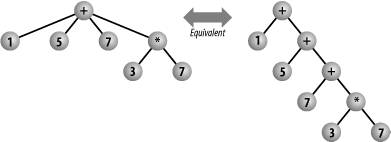|
|
Table of Contents |
|
Recipe 5.6. Performing an In-Order TraversalProblemYou have an XML document or fragment that represents an expression to be processed in-order. SolutionAn in-order traversal is most applicable to a binary tree. The general form of the algorithm in this case follows: <xsl:template match="node( )">
<!--Process left subtree -->
<xsl:apply-templates select="*[1]"/>
<!-- Do something with current node -->
<!--Process right subtree -->
<xsl:apply-templates select="*[2]"/>
</xsl:template>However, in-order traversal can extend to n-ary trees with the following algorithm: <xsl:template match="node( )">
<xsl:variable name="current-node" select="."/>
<!--Process left subtree -->
<xsl:apply-templates select="*[1]"/>
<!-- Do something with $current-node -->
<!-- Apply recursively to middle children
<xsl:for-each select="*[position( ) > 1 and position( ) < last( )">
<!-- Process "left" subtree -->
<xsl:apply-templates select="."/>
<!--Do something with $current-node -->
</xsl:for-each>
<!--Process right subtree -->
<xsl:apply-templates select="*[last( )]"/>
</xsl:template>The rationale behind this algorithm can be better understood by considering Figure 5-1, which shows the binary equivalent of an n-ary tree. The generalized n-ary in-order traversal produces the same result as the binary in-order traversal on the binary equivalent tree. Figure 5-1. N-ary to binary tree equivalent DiscussionThis form of traversal has a much narrower range of applicability then other traversal examples in this chapter. One notable application, shown in Example 5-8 and Example 5-9, is as a component of a stylesheet that converts MathML markup to C or Java-style infix expressions. Example 5-10 shows the output. Example 5-10. Input MathML fragment<apply>
<eq/>
<apply>
<plus/>
<apply>
<minus/>
<ci>y</ci>
<cn>2</cn>
</apply>
<apply>
<times/>
<cn>4</cn>
<apply>
<plus/>
<ci>x</ci>
<cn>1</cn>
</apply>
</apply>
<cn>8</cn>
</apply>
<cn>0</cn>
</apply>Example 5-11. In-order traversal of MathML fragment to produce a C expression<?xml version="1.0" encoding="UTF-8"?>
<xsl:stylesheet version="1.0"
xmlns:xsl="http://www.w3.org/1999/XSL/Transform"
xmlns:C="http://www.ora.com/XSLTCookbook/nampespaces/C">
<xsl:output method="text"/>
<xsl:strip-space elements="*"/>
<!-- Table to convert from MathML operation names to C operators -->
<C:operator mathML="plus" c="+" precedence="2"/>
<C:operator mathML="minus" c="-" precedence="2"/>
<C:operator mathML="times" c="*" precedence="3"/>
<C:operator mathML="div" c="/" precedence="3"/>
<C:operator mathML="mod" c="%" precedence="3"/>
<C:operator mathML="eq" c="= =" precedence="1"/>
<!-- load operation conversion table into a variable -->
<xsl:variable name="ops" select="document('')/*/C:operator"/>
<xsl:template match="apply">
<xsl:param name="parent-precedence" select="0"/>
<!-- Map mathML operation to operator name and precedence -->
<xsl:variable name="mathML-opName" select="local-name(*[1])"/>
<xsl:variable name="c-opName"
select="$ops[@mathML=$mathML-opName]/@c"/>
<xsl:variable name="c-opPrecedence"
select="$ops[@mathML=$mathML-opName]/@precedence"/>
<!-- Parenthesis required if the precedence of the containing
expression is greater than current sub-expression -->
<xsl:if test="$parent-precedence > $c-opPrecedence">
<xsl:text>(</xsl:text>
</xsl:if>
<!-- Recursively process the left sub-tree which is at
position 2 in MathML apply element-->
<xsl:apply-templates select="*[2]">
<xsl:with-param name="parent-precedence"
select="$c-opPrecedence"/>
</xsl:apply-templates>
<!-- Process the current node (i.e. the operator at
position 1 in MathML apply element -->
<xsl:value-of select="concat(' ',$c-opName,' ')"/>
<!-- Recursively process middle children -->
<xsl:for-each select="*[position( )>2 and
position( ) < last( )]">
<xsl:apply-templates select=".">
<xsl:with-param name="parent-precedence"
select="$c-opPrecedence"/>
</xsl:apply-templates>
<xsl:value-of select="concat(' ',$c-opName,' ')"/>
</xsl:for-each>
<!-- Recursively process right subtree-->
<xsl:apply-templates select="*[last( )]">
<xsl:with-param name="parent-precedence"
select="$c-opPrecedence"/>
</xsl:apply-templates>
<!-- Parenthesis required if the precedence of the containing
expression is greater than current sub-expression -->
<xsl:if test="$parent-precedence > $c-opPrecedence">
<xsl:text>)</xsl:text>
</xsl:if>
</xsl:template>
<xsl:template match="ci|cn">
<xsl:value-of select="."/>
</xsl:template>
</xsl:stylesheet>Example 5-12. Outputy - 2 + 4 * (x + 1) + 8 = = 0 Obviously, this stylesheet is not a full-fledged MathML-to-C translator. However, Chapter 9 discusses this problem more thoroughly. |
|
|
Table of Contents |
|